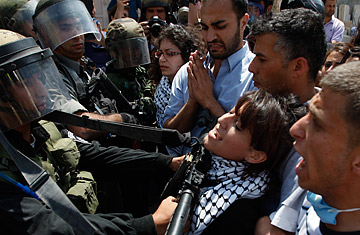
An Israeli police officer scuffles with a Palestinian protester during clashes at the Qalandia checkpoint, near the West Bank city of Ramallah, on June 5, 2011
On Sunday, the anniversary of the 1967 defeat of Arab armies that led to the Israeli occupation of the West Bank, the Gaza Strip and the Golan Heights, the Palestinian efforts at channeling the energies of the Arab Spring were on display, with varying results.
Television images from the Golan Heights village of Majdal Shams showed apparently unarmed Palestinian civilians marching peacefully down a hill toward Israeli soldiers who had assumed firing positions. Then came a crackle of gunshots; bloodied bodies were later carried back up the hill. It went on for hours, with 20 people reported dead, according to Syrian state television. The human cost was high, but for a Palestinian movement trying to reframe itself, the footage at least set it on a course along on the lines of Birmingham, Soweto and Gandhi's Salt March — parallels it has been making explicitly.
In contrast, a similar Palestinian march on the same day at the edge of Jerusalem will probably not quite make it onto a sampler of successful nonviolent protests. As noon approached, about 100 Palestinians and sympathetic foreign nationals gathered on the main road between the Qalandia refugee camp in the West Bank and the Holy City and prepared to head to the separation barrier and tangle of steel, concrete and loudspeakers that make up the forbidding military checkpoint that Israel has erected to bar the way to Jerusalem. "Our goal? To bring down the wall," says Mohammed Slamyieh, 26, who made the trip from the southern city of Hebron. How? "Hope," he says. "Lots of hope."
But also through some logic — as demonstrated by recent events. If by gathering peaceably day after day, thousands of Tunisians and Egyptians managed to topple dictatorships essentially by force of moral outrage, Palestinians might deploy the tactic against a military occupation that has gone on for 44 years. Given Israel's sensitivity to international pressure, such a campaign might force concessions from the Israelis that would make peace negotiations at least credible again — and perhaps produce a withdrawal.
It had to be peaceful, though. Any form of violence from the protesters would make Israeli military action look justified. "If someone throws a rock today, he's with them," says Fadwa Tmazi, wearing a white cap at a jaunty angle over a headscarf. By "them," she means the Israelis. "He's in the middle. He's a collaborator, working with them in order to show we're incapable of having a nonviolent demonstration." But she has a corollary. "Or they're little kids," she explains. "This is how little kids express how they feel."
And so a few dozen protestors set off, chanting through stop-and-go traffic as they marched the three or four blocks to the checkpoint. As they passed, shopkeepers scrambled to pull their goods inside and fold shut their iron doors. "You see what's happening," says Ahmad, frantic to get bolts of fabric into his upholstery store. "In about 10 minutes they'll be shooting and all my products will be messed up."
Asked if he didn't think the march was nonviolent, Ahmad replies "La, la" — Arabic for no. "Because they will now begin to shoot."
Fifteen seconds later, the first booms sound, and tear-gas canisters arc across the noon sky. One lands in the bed of a pickup, which, as it moves through traffic, distributes the awful smoke for two blocks, like a mosquito-control truck crawling through a residential neighborhood at dusk. "We haven't even started yet!" cries Lama Horani, scrambling into the alley beside the store. Between gasps, she points to her hip, struck by a tear-gas canister.
Journalists and other witnesses said the Israeli forces made the first move, firing tear gas and sound grenades as the first marchers approached the checkpoint. Moments later, small knots of young Palestinian men answered with stones. News crews set up their tripods between them, swiveling from soldiers to rock throwers in a scene that one foreign cameraman said he wouldn't even bother filing, it was so wearily familiar.
"It was a nonviolent event, that's what we wanted," says Slamyieh, on a sidewalk crowded with people trying to stay out of the range of the tear gas. "And you saw what happened. It'll stay like this all day until they decide to leave. As usual."
Fares Deek, a university student a few steps away, tries to be philosophical but sounds fatalistic instead. "Even if a kid did bring his slingshot with him, it's an entirely natural thing for him to do. So he can resist them. We had a big chance with Oslo to establish a Palestinian state, and from '93 till today, nothing has happened. On the contrary, things are getting worse. More settlements are built. Prisoners are in jail. And there is no hope from our politicians. What are we gonna do?"
